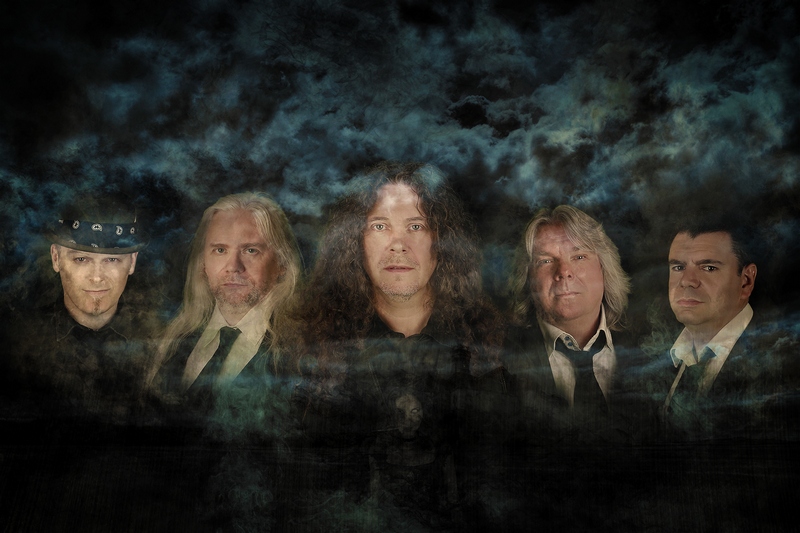
The eighth Arena studio album, 'The Unquiet Sky', is a concept inspired by M.R James' 1911 short story, "Casting the Runes". The story itself, as well as its 1957 film adaptation, "Night of the Demon", has always held a special place in Clive Nolan's memory and, not surprisingly, with its gloomy mood and a decent dose of the supernatural, it served as a perfect material for the next Arena release. John Mitchell suggested the title and the band got down to work.
Creative process, however, is complex and time consuming. Hence, from the birth of the idea till the album's completion, it took almost 5 months of work. The lyrics came first - much of them written in fever during the autumn Pendragon tour. As Clive recalls, he felt the urge to write and capture the flow of thoughts tumbling in his head, in an as unquiet and disorderly fashion, as the events of the libretto itself. In the end, it was a great surprise to him how many of these initial drafts ended up on the album in an almost unchanged version.

Lyrically the album is a loose adaptation of the original story, focusing more on the events than particular characters. The plot revolves around the theme of the curse, which, unless passed onto someone else, ends your life on the 30th day. M.R. James' idea opened ground for a series of philosophically pregnant lyrics brooding over sense of existence, passing time, value of life, death and randomness of fate. Nota bene, all of the above are recurring motives explored regularly throughout Clive's literary works. “The Unquiet Sky”, like all its predecessors, is rich in symbols, subtle allusions and vast cultural context... in a classic Nolan style. A piece of art of its own.
Musically, the album is the outcome of collective writing efforts of Clive and Mick Pointer, with Paul Manzi's original material in two songs, Kylan Amos' contribution to one song and additional material by John Mitchell. The album opens with "Hitchcock Orchestra", Clive's orchestral piece, a short bow towards the aforementioned "Night of the Demon" - the film and its era. The intro transforms into a much harder tune of "The Demon Strikes", introducing us into the unquiet realm of the story. Unmistakably, it is Arena in its top form! Disturbance and uneasiness of the mood, channelled through masterly guitar parts, world class vocal, heavy sound of keyboards and fair complexity of the rhythm section, is almost tangible. The curse is coming - the runes have been cast!

What follows is a customary Arena combination of heavy guitars, interesting rhythms, melodic vocal lines and imaginative keyboard arrangements. Two Paul Manzi ballads, “How Did it Come to This?” and “Unexpected Dawn”, the mellowest compositions on the album, hypnotise with dramatic vocal and the piercing sadness of Mitchell's solos against Manzi's acoustic guitar. “The Bishop of Lufford” and “No Chance Encounter” develop the plot with nightmarish visions, offering nice treats for fans of John Mitchell's heavier sound and Mick Pointer's inventive rhythmical sequences. “Markings on a Parchment” is an instrumental piece based on Kylan Amos' intriguing bass motive. (And by the way, by no means is it the only bass part worth cheering – Kylan turned out to be a perfect choice for the band!). The composition eventually transforms into the title track. With more musical references to the 1950s, choral bits, an exquisite guitar solo, Paul's breathtaking vocal performance, and dramatic piano parts, “The Unquiet Sky” is a definite highlight of the album, bearing all traces of a potential hit. “What Happened Before” is another feast for enthusiasts of Mitchell's guitars and Nolan's piano sounds, while “Time Runs Out” and “Returning the Curse” will please prog fans with classic progressive keyboard developments. “Traveller Beware” constitutes a stylish culmination of the album in the best Arena tradition, including engaging pace alterations and instrumental and vocal virtuosity. To choose just one or two personal favourites would be a difficult task to perform. The album consists of 12 complex compositions with no banal progressions or trivial solutions. The return of Simon Hanhart as a producer, undoubtedly had a clear impact on the ultimate sound of the release too.
To complement the musical and lyrical side of the venture, the album comes with an elegant booklet comprising credits, a full set of lyrics and an impressive collection of Kylan Amos' graphics. In his artwork, Kylan succeeded in capturing the eerie, turbulent mood of the songs. The observant minds can indulge in a challenge of spotting some of Arena's old emblems, cleverly woven into the tapestry of new images and visions. It is also interesting to note that Kylan's wife served as his muse and a model in quite a few of these demonic fantasies. The effect is visually stunning and fascinating to study. All in all, “The Unquiet Sky” is a classic Arena album... but better, richer, more lavish and more mature. Hats off to the quintet for their hard work! We will celebrate their 20th anniversary with what certainly is one of the best albums in the band's career.